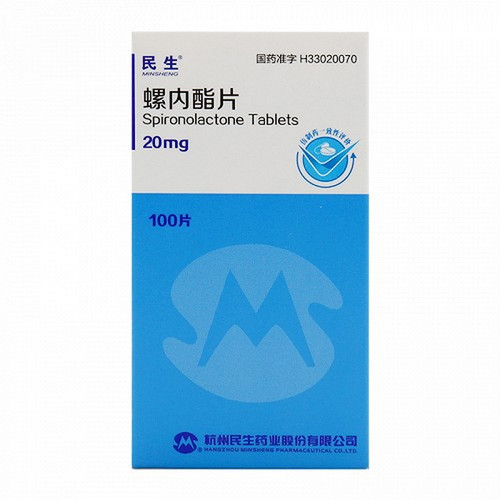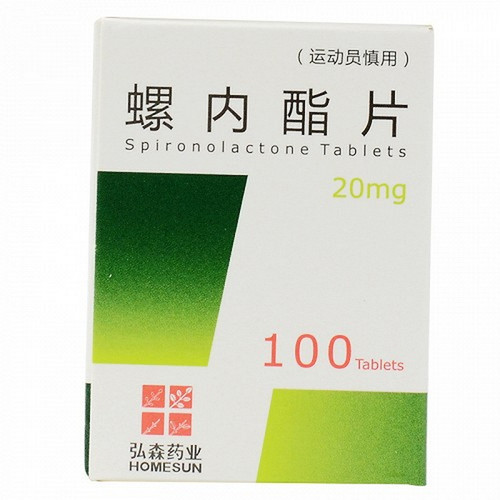Product Overview
[Drug Name]
Generic Name: Spironolactone Tablets
Trade Name: Xinyi
English Name: Spironolactone Tablets
Chinese Pinyin: LUONEIZHI PIAN
[Ingredients]
Spironolactone
[Properties]
This product is a white tablet.
[Indications]
1. Edema: Used in combination with other diuretics to treat edema, such as congestive edema, ascites due to cirrhosis, and renal edema. The goal is to correct the secondary increased aldosterone secretion associated with these conditions and counteract the potassium-excreting effects of other diuretics. It is also used to treat idiopathic edema. 2. Hypertension: Used as an adjunct to the treatment of hypertension. 3. Primary Aldosteronism: Spironolactone can be used for the diagnosis and treatment of this condition. 4. Prevention of Hypokalemia: Used in combination with thiazide diuretics to enhance the diuretic effect and prevent hypokalemia.
Dosage and Administration:
1. Adults: ① For the treatment of edema, take 40-120 mg daily in 2-4 divided doses for at least 5 consecutive days. Adjust the dose as appropriate thereafter. ② For the treatment of hypertension, initially take 40-80 mg daily in divided doses for at least 2 weeks, then adjust the dose as appropriate thereafter. It should not be used in combination with angiotensin-converting enzyme inhibitors to avoid increasing the risk of hyperkalemia. ③ For the treatment of primary aldosteronism, preoperative patients should take 100-400 mg daily in 2-4 divided doses. For patients who are not suitable for surgery, a lower maintenance dose should be used. ④ For the diagnosis of primary aldosteronism, for long-term trials, take 400 mg daily in 2-4 divided doses for 3-4 consecutive weeks. For short-term trials, take 400 mg daily in 2-4 divided doses for 4 consecutive days. Elderly individuals are more sensitive to this drug, so a lower initial dose is recommended. 2. For the treatment of edematous diseases in children, initially take 1-3 mg/kg body weight or 30-90 mg/m² per body surface area daily, in a single dose or divided into 2-4 divided doses. After 5 consecutive days, the dose may be adjusted as appropriate. The maximum dose is 3-9 mg/kg or 90-270 mg/m² per day.
[Adverse Reactions]
1. Common side effects include: ① Hyperkalemia, which is the most common, especially when used alone, in conjunction with a high-potassium diet, with potassium supplements or potassium-containing medications such as penicillin potassium, and in the presence of renal impairment, oliguria, or anuria. Even with coadministration of thiazide diuretics, the incidence of hyperkalemia can reach 8.6%-26%, often with cardiac arrhythmias as the initial manifestation. Therefore, close monitoring of serum potassium and electrocardiograms is essential during treatment. ② Gastrointestinal reactions, such as nausea, vomiting, stomach cramps, and diarrhea. There have also been reports of peptic ulcers. 2. Rare side effects include: ① Hyponatremia, which is rare when used alone but increases in incidence when used in combination with other diuretics; ② Antiandrogenic effects or effects on other endocrine systems. Long-term use of this drug can cause gynecomastia, impotence, and sexual dysfunction in men, and breast tenderness, hoarseness, increased hair growth, menstrual disorders, and decreased sexual function in women; ③ Central nervous system manifestations. Long-term or high-dose use of this drug can cause walking incoordination and headaches. 3. Rare side effects include: ① Allergic reactions, such as rashes and even dyspnea; ② Transient elevations in plasma creatinine and urea nitrogen, primarily related to excessive diuresis, insufficient effective blood volume, and decreased glomerular filtration rate; ③ Mild hyperchloremic acidosis; ④ Tumors. Five patients have been reported to develop breast cancer after long-term use of this drug and hydrochlorothiazide.
[Contraindications]
This drug is contraindicated in patients with hyperkalemia. [Precautions]
1. Use with caution in the following conditions: ① Anuria; ② Renal insufficiency; ③ Hepatic insufficiency, as this drug may induce hepatic coma due to electrolyte imbalances; ④ Hyponatremia; ⑤ Acidosis. Acidosis may exacerbate or precipitate hyperkalemia caused by this drug; on the other hand, this drug may exacerbate acidosis; ⑥ Breast enlargement or menstrual disorders. 2. Dosing should be individualized, starting with the lowest effective dose to minimize the occurrence of side effects such as electrolyte imbalance. If the drug is taken once daily, it should be taken in the morning to avoid increased nocturnal urination. 3. Before use, the patient's blood potassium level should be determined. However, in some cases, the blood potassium level may not represent the body's potassium level. For example, in acidosis, potassium shifts from intracellular to extracellular space, which can lead to hyperkalemia. Blood potassium can decrease after the acidosis is corrected. 4. This drug has a slow onset and a long duration of effect. Therefore, the initial dose may be increased to 2-3 times the usual dose, and the dose may be adjusted as appropriate. When used in combination with other diuretics, this medication may be taken 2-3 days before other diuretics. When this medication is added to other diuretics, the dosage of the other diuretic may be reduced by 50% for the first 2-3 days, with subsequent dose adjustments as appropriate. This medication should be discontinued 2-3 days before other diuretics. 5. If hyperkalemia occurs during medication use, discontinue the medication immediately. 6. This medication should be taken with or after meals to minimize gastrointestinal side effects and potentially increase its bioavailability. 7. Diagnostic Interference: ① It may increase plasma cortisol concentrations measured by fluorescence. Therefore, this medication should be discontinued 4-7 days before blood collection or an alternative measurement method should be used. ② It may increase the following measurement values: plasma creatinine and urea nitrogen (especially in patients with pre-existing renal impairment), plasma renin, serum magnesium, and potassium; urinary calcium excretion may increase, while urinary sodium excretion may decrease.
[Use in Special Populations]
Precautions for Children: This study has not been conducted and no reliable references are available.
Precautions During Pregnancy and Lactation: Use with caution in pregnant and lactating women.
Precautions for the Elderly: Elderly individuals are more susceptible to hyperkalemia and excessive diuresis.
[Drug Interactions]
1. Adrenocortical hormones, especially those with strong mineralocorticoid effects, such as adrenocorticotropic hormone (ACTH), can weaken the diuretic effect of this drug and antagonize its potassium-retaining effect. 2. Estrogens can cause sodium and water retention, thereby weakening the diuretic effect of this drug. 3. Nonsteroidal anti-inflammatory analgesics, especially indomethacin, can reduce the diuretic effect of this drug and increase nephrotoxicity when used in combination. 4. Sympathomimetics can reduce the antihypertensive effect of this drug. 5. Dopamine can enhance the diuretic effect of this drug. 6. Combination with drugs that cause hypotension can enhance both the diuretic and antihypertensive effects. 7. The risk of hyperkalemia increases when used in combination with the following medications: potassium-containing medications, stored blood (potassium content 30 mmol/L, or up to 65 mmol/L if stored for more than 10 days), angiotensin-converting enzyme inhibitors, angiotensin II receptor antagonists, and cyclosporine A. 8. The risk of hyperkalemia decreases when used in combination with glucose-insulin solutions, alkaline agents, and sodium-type potassium-lowering exchange resins. 9. This drug prolongs the half-life of digoxin. 10. Combination with ammonium chloride can easily lead to metabolic acidosis. 11. Combination with nephrotoxic drugs can increase nephrotoxicity. 12. Sodium carbenoxolone and licorice-based preparations have aldosterone-like effects and may reduce the diuretic effect of this drug.
[Pharmacological Actions]
This drug is structurally similar to aldosterone and is a competitive inhibitor of aldosterone. It acts on the distal convoluted tubule and collecting duct, blocking Na+-K+ and Na+-H+ exchange. This results in increased excretion of Na+, Cl-, and water, decreased excretion of K+, Mg2+, and H+, and variable effects on Ca2+ and P3-. Because this drug only acts on the distal convoluted tubule and collecting duct, and has no effect on other segments of the renal tubule, its diuretic effect is relatively weak. Furthermore, this drug also has effects on aldosterone target organs outside the renal tubules.
[Storage] Store tightly closed in a dry place.
[Specifications] 20mg x 100 tablets
[Packaging Size] Box
[Expiration Period] 36 months
[Approval Number] National Medicine Standard H31021273
[Manufacturer] Company Name: Shanghai SPH Xinyi Pharmaceutical Co., Ltd.






